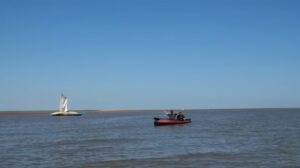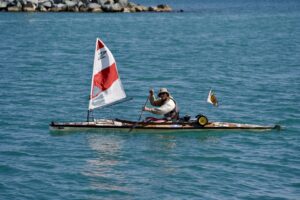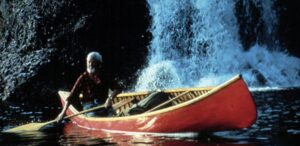According to the U.S. Geological Survey, Africa’s Nile River is 6,650 kilometers long and South America’s Amazon is 6,400 kilometers. However, the question of a river’s length is not straightforward. Cartography, geography, and personal opinion all muddy the waters.
Conventional knowledge holds that the Nile, which starts in central and eastern Africa and ends on Egypt’s Mediterranean coast, is the world’s longest river. But some dispute this, because there is no scientific consensus about where the rivers start.
Broadly speaking, the Amazon starts in the Peruvian Andes and ends on Brazil’s Atlantic coast. The conventional source of the Amazon is the Apurimac River in southern Peru. Satellite images from 2008 allegedly confirmed the claims of a Royal Geographic Society expedition in 1996 that extended the Amazon’s length by adding the length of a feeder stream called Apacheta Creek to the Apurimac. This lengthened the Amazon by an extra 593km and made it 6,993km long — longer than the Nile.

The Amazon starts from several proposed sources high in the Andes, including the Apurimac River. Source: Shutterstock
Yuri Sanada, a Brazilian filmmaker, wants to settle the Amazon vs. Nile debate once and for all. In April 2024, he will mount an expedition from Apacheta Creek to the mouth of the river, highlighting the Amazon’s superior length to the Nile. Though many have traversed the Amazon River before, his expedition will be the first to do so in solar-powered boats.

Expedition leader Yuri Sanada. Photo: Yuri Sanada
An imperfect science
The source of the Amazon remains contentious. James Contos, a kayaker and explorer, published an article in 2014 claiming an alternative source on the Mantaro River. Some 640km north of Apacheta Creek, this adds about 80km to the Amazon’s length instead of the 593km if the Apacheta Creek source is used as the starting point. The Contos source would make the Amazon shorter than the Nile.
This raises the question as to whether it is the perennial or the ephemeral source that counts. A perennial source provides a continuous flow of water from a river’s mouth, while an ephemeral source does not flow year-round. Crucially, researchers have pointed out that the Contos source is ephemeral, whereas the Apacheta Creek source provides continuous flow. 
Sanada will use both proposed sources of the Amazon as starting points. Applying each of these to the Amazon makes a difference of 6,510km (Contos’ ephemeral Mantaro source) to 6,993km (the perennial Apacheta Creek source). The unsettled debate revolves around whether a perennial or ephemeral source counts as the true source.
West Hansen, an American kayaker who has paddled the length of the Amazon, argues that a universal set of criteria is needed for defining rivers, but these are not available. He further points out that requiring a perennial source would change the lengths of almost every major river in the world. In other cases, dams interfere with flow. Does that affect the length of these rivers?
The source of the Nile faces similar controversy. The river’s main two branches are the White and Blue Niles. The Blue Nile originates in Ethiopia’s Lake Tana and is a perennial source that provides 80% of the Nile’s water.
The White Nile, also perennial, is longer but doesn’t contribute such a large proportion of the river’s volume. In that case, should it count as the true source by which one measures an entire river’s length?
Any comparison of rivers needs to be consistent over what starting point it uses. Otherwise, it’s impossible to compare expedition accomplishments, just as it’s impossible to compare various crossings of Antarctica, where some include the ice shelves and some don’t. Therefore, whether the Amazon is longer than the Nile is not simply about distance, but requires claimants to be specific about the criteria they are using to make comparisons.
The creek of the matter
Either way, the burden of proof is on those who identify the Apacheta Creek as the source. This would mean the start of the Amazon is a small glacial creek high in the Andes. If it is a justifiable claim, then it seems likely the Amazon is indeed longer than the Nile.
The science behind Sanada’s claim is based on the Royal Geographic Society expedition from 1996, satellite imagery from 2008, and a study published in 2011 in the Hydrological Sciences Journal, supporting the earlier study from 1996. However, the conclusions of this research have met with considerable skepticism in the scientific and geographic communities, as reported by The Washington Post.
A persistent problem in all of these claims is the difficulty of obtaining specific, accurate, and consistent measurements of length. In the Amazon, extreme weather in the Andes and the Amazon rainforest erodes river banks, bends, and shorelines. Consequently, there are large variances in key measurement features. Over thousands of kilometers, that can make consistent measurements almost impossible. So the true length of the Amazon, regardless of its source, shifts all the time.

Erosion and the shifting banks of the Amazon make accurate measurements difficult. Photo: Shutterstock
Nevertheless…
Next spring, Sanada’s team will spend seven months mapping and measuring the river from both the Apacheta Creek and Contos’ source. The point, says Sanada, is that the waters from the Andes are the same that flow into the Atlantic. His journey aims to highlight that and point to the evidence that it is longer than the Nile.
Such a journey implies significant danger. Apart from the sometimes hostile natural environment, the Amazon is a significant smuggling route for drug traffickers, and river pirates lurk in parts of the river. British canoeist Emma Kelty was killed during a solo journey down the Amazon in 2018. The team will need to work with local authorities to secure armed local escorts through such dangerous areas.
The expedition will involve hiking, donkeys, rafts, and hybrid electric boats. Sanada says that scientists will join the expedition at different stages.

Sanada’s expedition will use specially designed and built hybrid eco-boats. Photo: Amazonadventure.org
The final word
“More than 1,500 people have rowed or paddled across an ocean,” Sanada told The Washington Post. “But to kayak down the entire Amazon? That has been done fewer than 10 times, and all of them were for adventure’s sake. To document the entire river, its geography, and biodiversity, this has never been done.”






